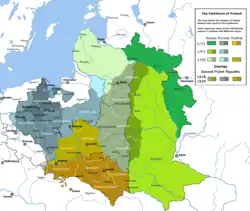Self-Defence of Lithuania and Belarus (Polish: Samoobrona Litwy i Białorusi) were voluntary military formations created during the reconstitution of sovereign Poland towards the end of World War I in the Kresy macroregion, formerly the Western Krai of the Russian Empire. Self-Defence units were composed mostly of Poles loyal to the nascent Second Polish Republic, formed after a century of Partitions.[1] Their areas of operation were centered around Vilnius (Wilno), Minsk (Mińsk) and Grodno. In January 1919, the Polish Self-Defence was officially organized as the 1st Lithuanian–Belarusian Division; the division took part in the Polish–Soviet War of 1919–1920.[1]
History

The local Self-Defence units were formed in 1918. They were primarily involved in protecting residents from the Russian Army deserters and other threats. The Self-Defence quelled robbery by peasants and fought the Bolsheviks, who followed the retreating German forces.[1]
On 8 December 1918 General Władysław Wejtko, formerly of the Imperial Russian Army and one of the organizers of the Self-Defence, arrived in Warsaw, the capital of Poland. Polish Chief of State Józef Piłsudski confirmed his military rank of Lieutenant general in the newly-formed Polish Army and nominated him to be the leader of all Polish voluntary forces in the area of present-day Lithuania and Belarus.[1] Wejtko received 375,000 marks from the Kresy Defense Committee for the current needs of the Self-Defence, including provisions, allowances, firearm purchase, and horses.[2]
The militias were soon overwhelmed by numerically superior Bolshevik armies. In December 1918 in Minsk, a group of 1,500 Poles and Belarusians under the Self-Defence banner rose to arms to defend the city against the advancing forces of Soviet Russia.[1] However, due to the Russian numerical superiority and the lack of ground support from the short-lived Belarusian National Republic, they withdrew toward Poland.
In early January 1919, a 2,500 men-strong Self-Defence force was created in the Vilnius Region to defend it against the Red Army. As a result of the four-day-long battle for Vilnius (Wilno) which lasted until 5 January, the Polish forces were pushed back near Naujoji Vilnia (Nowa Wilejka) and retreated in the southern direction, toward what used to be Regency Poland.[1] [Part 1] The area changed hands several times in the following months, during the Vilna offensive of 19–21 April 1919 and Operation Minsk of early August.[1]
In January 1919, most of the Self-Defence forces were joined into the 1st Lithuanian–Belarusian Division under the command of General Wejtko.[3] They officially became part of the Polish Army.
Citations
- 1 2 3 4 5 6 7 Krzysztof Janikula (August 25, 2008). "War of the 1920" [Wojna roku 1920 / cz. 1]. Vol. Part 1. Portal militarny Militaria.tm.pl. Archived from the original on August 28, 2008.
{{cite news}}: CS1 maint: bot: original URL status unknown (link) Continued at: "War of the 1920" [Wojna roku 1920 / cz. 2]. Vol. Part 2. Sources: Bohdan Skaradziński, "Sąd Boży 1920 roku." Andrzej Albert, "Najnowsza Historia Polski 1914-1993". Archived from the original on 2009-10-12.{{cite news}}: CS1 maint: bot: original URL status unknown (link) - ↑ "Self-defense in the Kresy (September 1918 – January 1919)" [Samoobrona Kresów (IX 1918 - I 1919)]. Kraków: Koło Kombatantów przy AGH (Combatants Club at the AGH University of Science and Technology). 2017. Archived from the original on 2017-12-30. Retrieved 2017-12-30.
- ↑ A. Łowczak, J.M. Sołdek (May 13, 2007). "General from Nałęczow - biography of Władysław Wejtko" [Nałęczowski generał]. Part 1. Gazetka. Szkoła im. Stefana Żeromskiego w Nałęczowie. (Part 2). Archived from the original on May 13, 2007 – via Internet Archive.
{{cite web}}: CS1 maint: bot: original URL status unknown (link)
References
- "1. Samoobrona kresów (IX 1918 – I 1919)." Archived 2017-12-30 at the Wayback Machine Koło Kombatantów przy AGH. Kraków, 2017.
- "2. Początkowy etap wojny polsko-bolszewickiej (II - XII 1919)." Archived 2017-12-30 at the Wayback Machine Koło Kombatantów przy AGH. Kraków, 2017.
- Short entry from Encyklopedia Interia (in Polish)